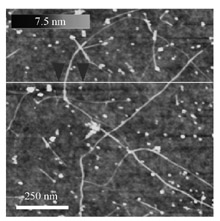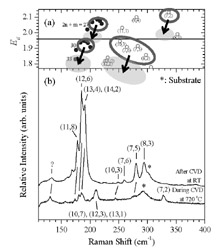Materials Science Laboratory
Whether we will be successful in applying carbon nanotubes (CNTs) to
electronic devices highly depends on our ability to synthesize CNTs with
a desired chirality, because the electronic structures of CNTs strongly
depends on their chirality. To control the growth of CNTs, it is important
to clarify their growth mechanism. We have investigated CVD growth processes
of CNTs by in-situ Raman observation. Raman spectra are strongly temperature-dependent because
they reflect the vibrational properties of observed materials. In order
to discuss the details of the growth process observed by in-situ Raman spectroscopy, temperature effects in the Raman spectra of CNTs should
be elucidated.
Figure 1 shows an atomic force microscope (AFM) image of a CNT-grown
sample. Individual CNTs lie on the substrate. Figure 2 shows (a) the experimental
Kataura plot and (b) RBM signals observed at 720 ℃ (during CVD) and at
room temperature (after CVD). The chiral indices of the RBM signals observed
at room temperature can be assigned as shown in Fig. 2(b) on the basis
of the experimental Kataura plot. The RBM peak frequencies tend to simply
decrease with increasing temperature. This is a commonly observed phenomenon
originating from the softening of the force constant with increasing temperature.
In addition, the relative intensities of each RBM peak change with temperature.
This temperature dependence is explained by the change in the resonance
condition of each RBM peak. The optical transition energy of nanotubes
decreases with increasing temperature, resulting in a shift of each point
in the Kataura plot to the lower left as shown in Fig. 2(a). From this
analysis, the chiral indices of the RBM peaks observed at CVD growth temperature
of 720 ℃ are successfully assigned as shown in Fig. 2(b) [1]. These results
encourage us to further investigation of the chirality-dependent growth
behavior of CNTs observed with in-situ Raman spectroscopy and, in future, will lead us to clarifying growth
mechanism and thereby achieve the chirality-controlled growth of CNTs.
[1] T. Uchida, et al., Appl. Surf. Sci., in press.
 |
 |
||||
|
|